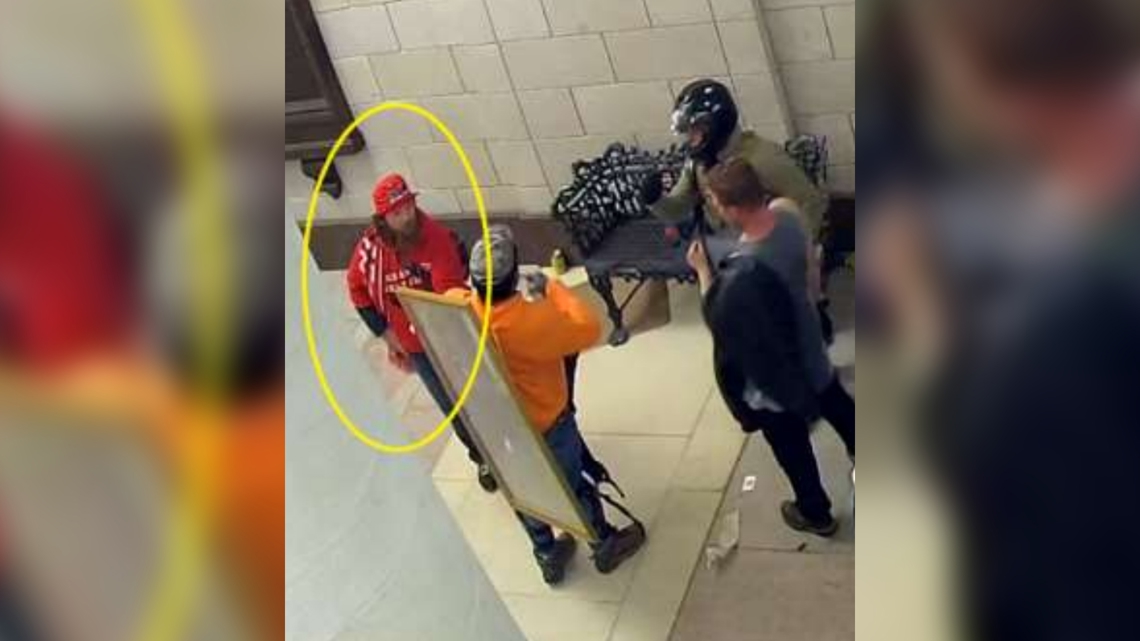Michael Gerard Fournier, of Maine, pleaded guilty to two misdemeanors for joining the mob at the U.S. Capitol on Jan. 6, 2021.
Federal prosecutors say an Army veteran who appears to have stopped another rioter from stealing a painting from the U.S. Capitol on Jan. 6 should nevertheless serve the maximum sentence allowed by the charge he pleaded guilty to.
Michael Gerard Fournier, 40, of Maine, was arrested in January on the four standard misdemeanors used in Capitol riot cases. He pleaded guilty in May to the two lesser charges of disorderly and disruptive conduct and parading, demonstrating or picketing in a Capitol building.
Both charges are class “B”, or petty, misdemeanors that carry a maximum sentence of six months in prison but which have resulted in far shorter sentences – many with no prison term at all – for hundreds of Jan. 6 defendants. Fournier has no criminal history and appears to qualify for a new federal sentencing guideline that went into effect in late 2023 intended to further reduce sentences for first-time offenders.
In a sentencing memo filed last week, prosecutors said Fournier, who received a Bronze Star while serving in the Army from 2002-2010, was an “active and aggressive participant” of the mob inside the Capitol on Jan. 6 and joined in on chanting and berating police. They acknowledge he appears in surveillance video to stop another rioter from stealing a painting – but argued that did little to mitigate his other actions that day.
“Fournier accepted responsibility by surrendering himself to the FBI and pleading guilty, and he may have prevented the theft of a painting,” prosecutors wrote. “But Fournier has remained silent about his conduct and has not expressed remorse for his actions on January 6, 2021.”


Much of the government’s argument for detention stems not from Fournier’s conduct inside the Capitol, but what he did after leaving. Prosecutors say once he’d exited the building he made his way to the west side, where he attempted – albeit unsuccessfully – to throw a flagpole at police. In their sentencing memo, prosecutors described Fournier using a scarf to protect his face from tear gas while he rushed toward a line of police with a flagpole. Prosecutors said Fournier attempted to throw the pole at officers like a juvenile, but “tripped and fell at the last second.” He then stood up and threw the pole, which it landed several feet away from police.
“Although Fournier’s assault was not successful and the flag never hit its intended target, this Court should consider it as part of Fournier’s relevant offense conduct and as part of his disorderly and disruptive conduct on Capitol grounds that day,” prosecutors wrote.
Although prosecutors have occasionally sought the maximum sentence for similar misdemeanor cases, judges have rarely gone along. In 2021, the DOJ sought six months in prison for Robert Reeder, of Maryland, after discovering evidence that he’d grabbed and pulled a police officer to the ground on Jan. 6. Reeder had already pleaded guilty to a single misdemeanor count of parading, demonstrating or picketing at the time the footage of the encounter was discovered. U.S. District Judge Thomas F. Hogan ultimately sentenced Reeder to three months behind bars. Reeder’s case caused prosecutors to add language to Jan. 6 plea deals allowing them to prosecute potential evidence of violent crimes discovered after a guilty plea is entered.
In the defense sentence memo filed Tuesday, Fournier’s attorney, John Pierce, argued the DOJ “tricked Fournier into accepting a very friendly plea deal” only to seek the maximum prison term at sentencing. Pierce’s memo sought a year of probation, no fine and no restitution – although Fornier’s deal includes the standard Jan. 6 misdemeanor agreement to pay $500 toward damage to the Capitol.
Fournier was scheduled to be sentenced in a Zoom hearing Thursday by D.C. District Chief Judge James Boasberg.
.png)









 English (US) ·
English (US) ·